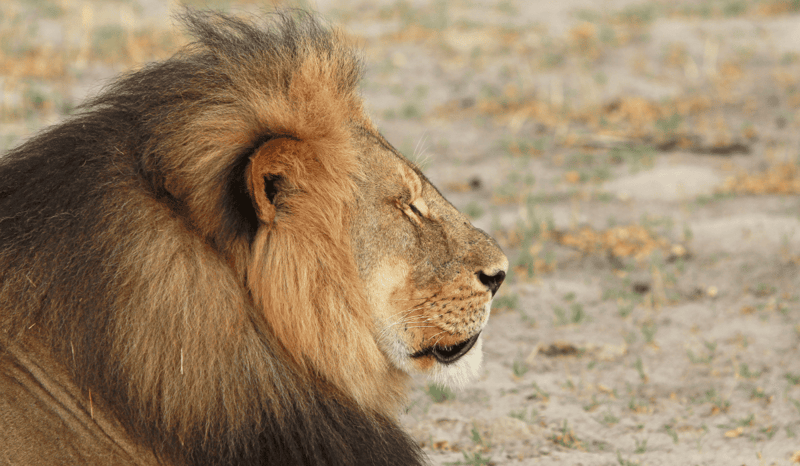
Beloved lions Cecil and Blondie were killed by trophy hunters in Zimbabwe, sparking global outrage. Discover why trophy hunting is pushing lions toward extinction—and how you can help protect them.
The world mourned deeply when Cecil the lion was brutally killed by a trophy hunter in Zimbabwe a decade ago. Cecil was more than just a lion; he was a symbol of wildlife conservation and a beloved figure in the Hwange National Park.
Now, we face another heartbreaking loss. Blondie—a lion collared and studied by the University of Oxford, pride leader of three lionesses and 10 cubs, and who represented hope for the future of Zimbabwe’s wild lion population—was also killed by trophy hunters in late June 2025.
This isn’t just about two lions. It’s about a decades-long crisis that threatens the very survival of these majestic animals and the ecosystems they help sustain.
Cecil and Blondie: Two Lions Who Changed the Conversation
Cecil was a well-studied, GPS-collared lion whose life was closely monitored by conservationists. His death sparked international outrage, shining a harsh spotlight on the cruel realities of trophy hunting. Blondie, who lived in the same region and was a direct descendant of Cecil’s pride, carried that legacy forward. He was a vital part of the pride’s social structure and the broader ecosystem.
Lions are apex predators, playing a critical role in maintaining balance in the wild. Removing key individuals like Cecil or Blondie destabilizes entire prides, disrupting breeding patterns and social cohesion, which can lead to further population declines.
Trophy Hunting: A False Solution to Conservation
Trophy hunting is often marketed as a tool to fund conservation efforts, but the truth is far more complex and troubling. The reality is that trophy hunting directly kills iconic, mature animals—the very lions that are crucial for healthy genetics and stable populations.
Some 10,000 lions have been shot by trophy hunters in the last decade alone, according to the Campaign to Ban Trophy Hunting (CBTH). This alarming number is set against a backdrop where African lion populations have declined by more than 90% in the last century—a devastating loss that threatens the survival of this species.
Conservationists estimate that lions have lost 95% of their historic range, leaving only about 24,000 left in the wild. This catastrophic decline is driven not only by trophy hunting but also by poaching for the illegal wildlife trade, habitat destruction, and human-wildlife conflict.
Studies have shown that removing dominant males leads to increased infanticide by new incoming males and weakens the pride. This cycle can cause significant harm to lion populations, many of which are already vulnerable or endangered.
Most Trophy Hunters Are American—Including Cecil’s Killer
It’s important to recognize who is driving this demand for lion trophies. The vast majority of trophy hunters are from the United States. In fact, the American dentist who killed Cecil sparked global outrage and became the face of the trophy hunting debate.
This demand for “big game” trophies by wealthy hunters from overseas fuels the cruel industry, making it a largely American-driven problem, even though the animals and habitats affected are thousands of miles away. Understanding this dynamic is crucial to addressing the root causes of trophy hunting and advocating for stronger protections.
How World Animal Protection Is Helping Lions
World Animal Protection is working to change the way the world sees and treats lions. In July 2025, we launched a new study showing that over 85% of community members living near Kruger National Park in South Africa support the introduction of a lion protection fee, also known as a lion levy. Instead of continuing the exploitation of lions through trophy hunting, this small, optional fee paid by tourists would directly fund conservation efforts.
This follows World Animal Protection’s 2023 international research, which revealed that more than 80% of tourists—including those visiting Zimbabwe—would also support such a fee during their travels. Initiatives like the lion levy offer a sustainable, ethical alternative to trophy hunting, ensuring that both local communities and wildlife benefit from tourism without sacrificing lives for sport.
Protecting Lions Means Protecting Their Lives
Lions (or any animal, for that matter) do not belong on a hunter’s trophy wall. They belong in the wild, where they can roam freely, hunt naturally, and live out their lives as they’ve done for millennia.
By ending trophy hunting and investing in non-lethal, community-based conservation, we can protect lions and their habitats. This includes promoting ethical wildlife tourism, empowering local communities, and supporting policies that ban or severely restrict trophy hunting.
What You Can Do
The deaths of Cecil and Blondie remind us that the fight to protect wild animals is far from over. Here’s how you can help:
- Speak out against trophy hunting: Use your voice on social media and in conversations to raise awareness.
- Support organizations like World Animal Protection working to end trophy hunting: Your donations and advocacy help fund vital protection and education efforts.
- Choose ethical wildlife tourism: Encourage responsible travel that benefits animals and local communities. Check out World Animal Protection’s Wildlife-Friendly Travel Guide for more information.
- Urge policymakers to ban trophy hunting and the imports of animal “trophies”: Push for legislation that protects lions and other vulnerable species.
Lions are symbols of strength, resilience, and the wild’s untamed beauty. Losing them to trophy hunters is a tragic reminder of how much more work we have to do.
Donate today so we can continue the fight to get justice for Cecil and Blondie and create a future where wild animals live free, safe, and protected.